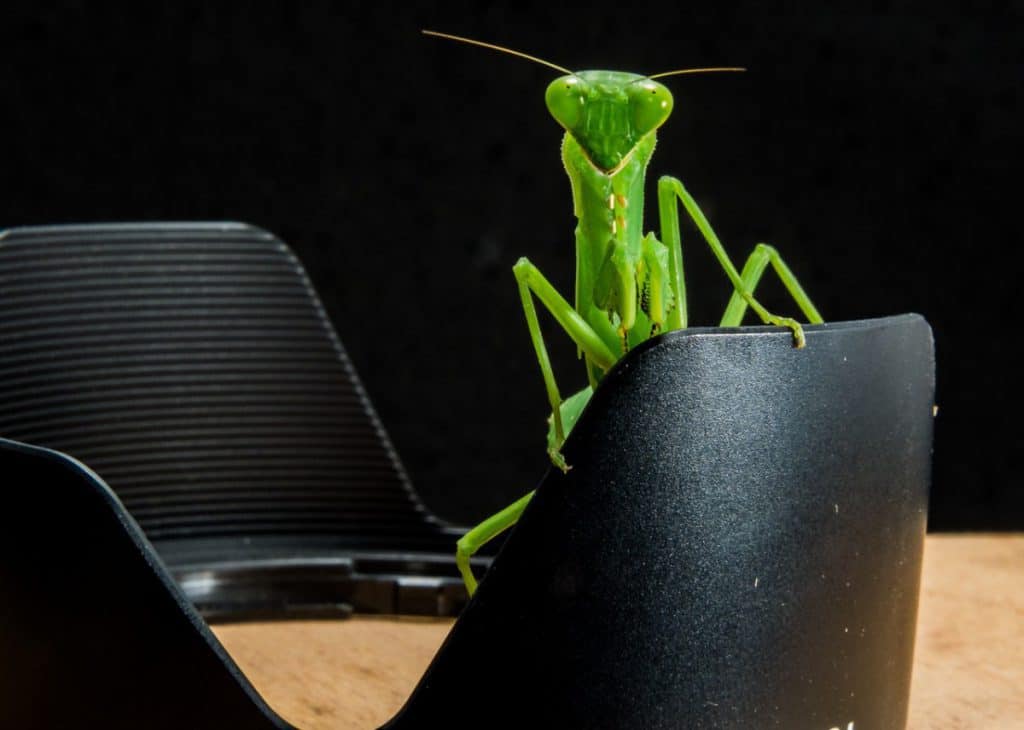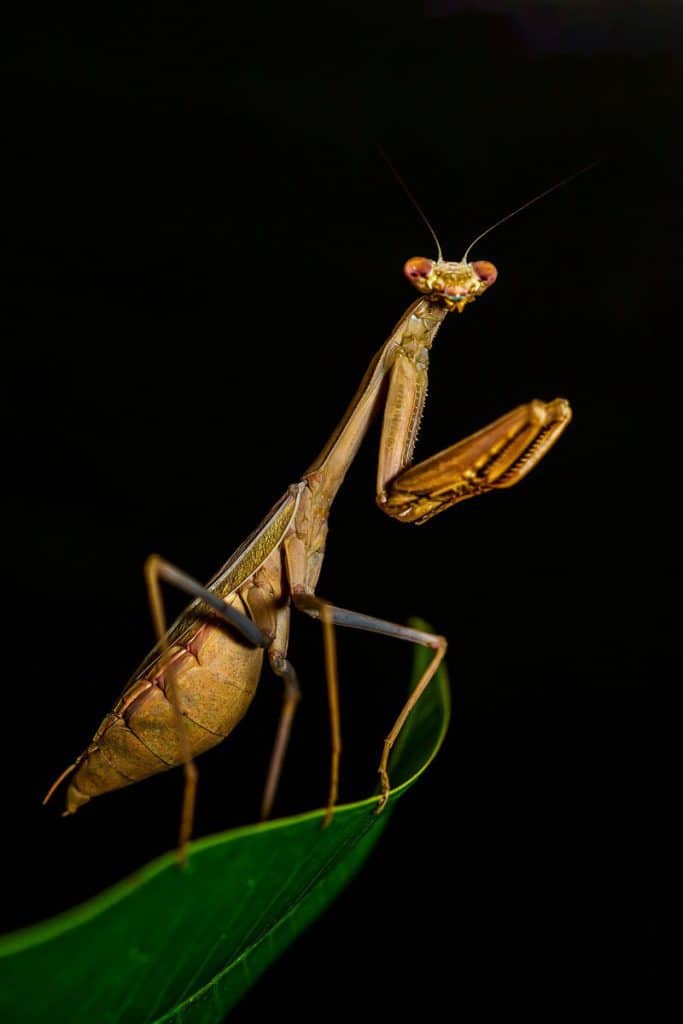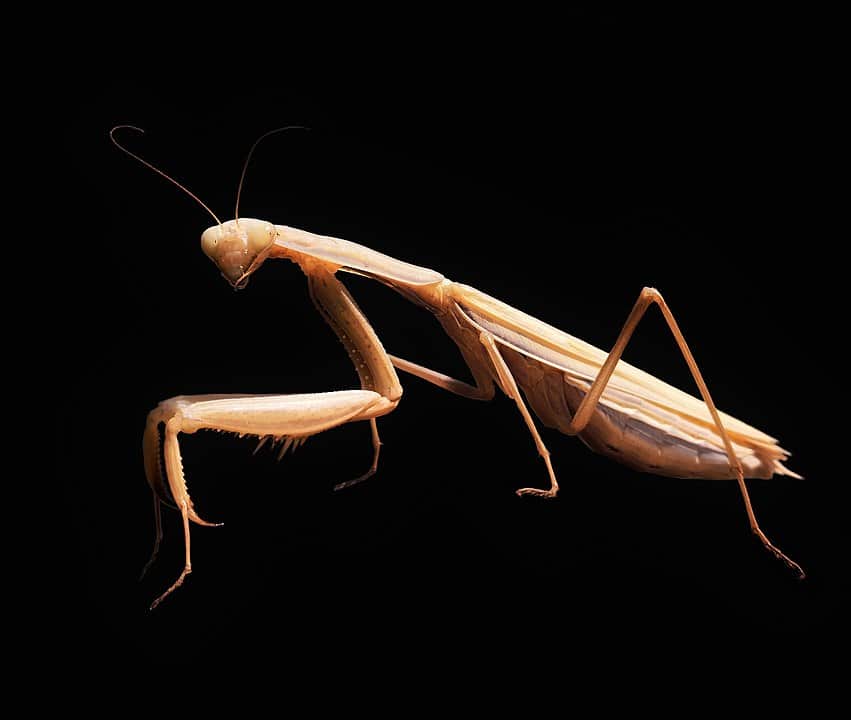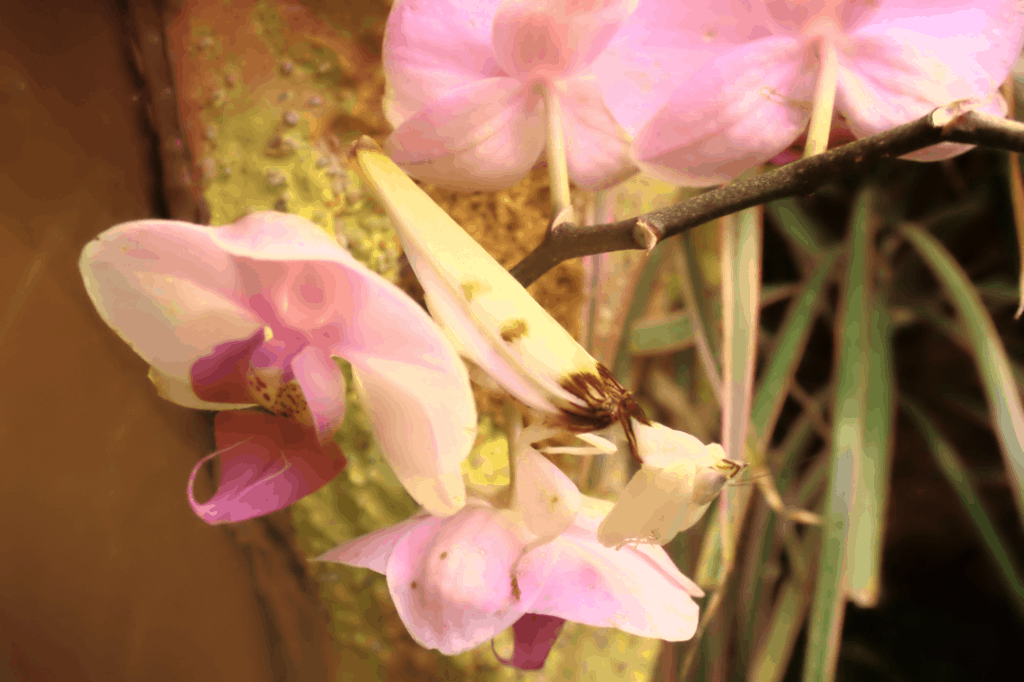
What does a praying mantis look like?
Although the praying mantis is not an extremely well-known insect, many people want to know, what color are praying mantis? The answer is not a simple one though. There are actually 2000 species of praying mantis and they live around the world. The color of these insects varies from brown to green and has adapted over time to allow them to blend into their habitat.
The color of the praying mantis is designed to provide camouflage. For this reason, it’s often common to see a green praying mantis in the United States. However, in other parts of the world where the habitat may be dry, expect to see brown praying mantis. Their goal is to become invisible to both predators and prey which they do well.
If you enjoy reading this article, why not check out our articles on Why Do I Have Cockroaches in My Home? and Are Ladybugs Poisonous?
Do Praying Mantis Change Color?

Since environments can change throughout the year, some have wondered whether a praying mantis can change its color. It was not believed that this could happen until fairly recently. Some scientists believe that a few of the mantis species actually can change their color. The European mantis is one species that is thought to have this ability. It predominantly lives in brown-grass habitats as well as green vegetation. Studies suggest that this type of mantis can transform into a green color when they live within the green grass, It’s theorized that this color change occurs after they molt. The weather patterns likely play a large role in their final color. Studies that have been done in controlled environments have shown variations based on temperature and humidity levels observed.
However, researchers do not believe that the mantis can change color like a chameleon. The temperature, humidity, and light intensity all play a role in their adaptations. But even with these factors, only the baby praying mantis has ever been though to change its color. Once they become adults, the mantis will stay their current color throughout the rest of their lives.
Lots of insects have fascinating colors. Ladybugs are a particularly interesting example. Find out more about their coloring here: The Color of Ladybugs – Explained.
White Praying Mantis
The white praying mantis looks similar to the traditional green kind although it has a wide abdomen. It can be found in a few areas although it’s common to see this species in the west. Its white color helps the mantis to avoid detection in desert climates.
However, the young praying mantis in almost every species is white until adulthood. Young mantis molt about 10 times as they grow. After each molt, they are a pure white color and they will darken to their true color if they are not the white species of mantis. For this reason, many people think of a white mantis as being an albino when in fact they are either a specific species or an immature mantis.
Brown Praying Mantis

The brown praying mantis is the most common color after green. They belong to the genus Mantodea and are a close relative to both cockroaches and termites. As one might suspect, the brown mantis primarily lives in tree trunks and branches. Their color helps them to blend into their preferred environment. It’s not uncommon to see a mantis that looks very much like a twig.
Although most species of praying mantis have wings, the brown praying mantis may or may not have wings. They will appear after the final molting and they play an important role in their lives. They can actually use their wings to catch moths. The wings are also used for transportation. The praying mantis that does not have wings may find itself at a disadvantage.
The brown praying mantis is not in one particular location but prefers to stay in warmer climates that have milder winters.
One particular type of brown praying mantis is known as the ghost mantis. It is actually a miniature species and will only grow to about two inches in adulthood. The ghost mantis has a distinct appearance, making it look like a decaying leaf with a flattened thorax as well as leaf-life protrusions from its limbs. This species actually lives in Africa although it can be live in Southern Europe as well. It prefers dry areas and often lives in bushes and shrubs which make it easier to hide.
Pink Praying Mantis

Also known as an orchid mantis, this is a type of mantis that lives in Southeast Asia. Its name is well understood once seeing the mantis as it has an orchid-like appearance. The brilliant coloring would make the mantis stand out in any other environment. However, its structure is adapted to blend into an orchid plant. Their four walking legs closely resemble flower petals while the front pair is used for grasping prey. This species is also noticeable for their variations in size. While the females are similar to a normal mantis size, the males are usually less than half of that size.
This species is also interesting since it can have a variation in shades of pink. In some situations, it may even appear as a brown color. This type of mantis is common in Indonesia and Thailand. However, they are rare and difficult to observe in nature, making them the most highly sought type of mantis today. The color of this mantis deceives predators but also attracts other insects for them to eat.
We think the Pink Praying Mantis is pretty cool looking. If you want to see and learn more about more cool bugs, read The Cutest Bugs in the World!
Green Praying Mantis
Although there are a number of mantis species that are green as adults, this type is native to the United States and the most commonly observed. Their appearance resembles a leaf in some species of green mantis. Others that tend to live in grass may have more slender bodies, allowing them to blend into their environment well. M. religiosa is a predominantly green type of mantis and they’re also widely spread. They can live throughout the world. This species also has wings as adults, making it easier to catch prey and attract or seek out a mate.
Black Praying Mantis
It’s likely that most people are not aware that a mantis can be black. However, one specific type of mantis also known as the bark mantis is a very rare species that is found in Southeast Asia. Its appearance is somewhat iridescent, although their coloring can vary slightly. They also look significantly different than other mantis species with a much shorter thorax than others.
This type of manti will actually rest under the bark of trees where it can feed on termites and other small insects. They will actually chase after their prey instead of ambushing them similar to other mantis species. They’re also unusual in that they are not cannibalistic which is a common trait among mantis. As one of the smaller species, they grow to about one and a half inches at adulthood. Because of their differences in body shape, they have a closer resemblance to a type of cricket or even beetle and are commonly mistaken for either. It’s not well-known why they appear to be a certain color although it’s likely that it plays a role in their survival.
Color and Function
As noted for almost every species of mantis, their color plays a significant role in their lifespan. Interestingly enough, the newly hatched mantis is most vulnerable because their color at that stage in life makes them stick out and more susceptible to predators.
Additionally, both the male and female mantis die after mating and laying eggs. They do not raise their offspring so the newly hatched mantis have to survive through molting in a highly dangerous environment. They will eat almost anything, including each other so a majority of the eggs laid will not survive to adulthood.
What does a praying mantis look like?
Their color is designed to allow them to blend into their environment and, as adults, they can do that well. Although they are agile creatures, most species of mantis will actually wait until prey comes close to them before striking. Appearing similar to a blade of grass, bark, or leaves makes them unnoticeable to any number of insects and animals.
What does a praying manties need to eat?
Praying mantis can eat bugs but they will also eat small birds although this is less common. They will not eat decreased insects and their desire to live prey requires that they can be indistinguishable from their environment. The average praying mantis can move rapidly but tends to conserve energy as a general preference.
Colors of Other Mantis Species
Although these are the primary colors found in mantis species, they can also have distinct patterns of colors. Some mantis is not a single solid color but will have spots, lines, or speckles that set them apart. These also help them to blend into their environments such as bark or leaves. It may be difficult to spot a mantis even to the trained eye.
Nothing their Colors
For anyone who wants to learn more about the mantis and their colors, many nature centers have praying mantis that can be observed in captivity. Some species of the praying mantis are actually endangered, making them a valued and protected insect in some areas. Anyone who has a garden may have mantis around in the warmer months, although it is rare to see them.
If you enjoyed reading this article, why not check out our articles on Can Spider Fangs Grow Back? Let’s Find Out and What Can Ants Climb? This Surprised Me!
P.S.
That’s it for this article. I hope you enjoyed reading it and if you think it might be useful for someone else then please share it on social media, email or your own website! It really encourages us to write more content and grow the site!
All the best
Steve
Sources:
Recent Posts
Tiny Black Bugs in Bathroom NO WINGS: What They Are and What to Do!
Finding tiny black bugs in your bathroom can be uncomfortable, to say the least. Especially if they are persistent, or they appear in very large numbers, which they often like to do. When it...
Tiny Black Bugs in Plant Soil - What Are They & What To Do About It
A short horror story: You get a new houseplant. You do your best to take care of it. You’ve ensured that it has the right soil, the right amount of sun, it gets enough water. And then one day, you...

